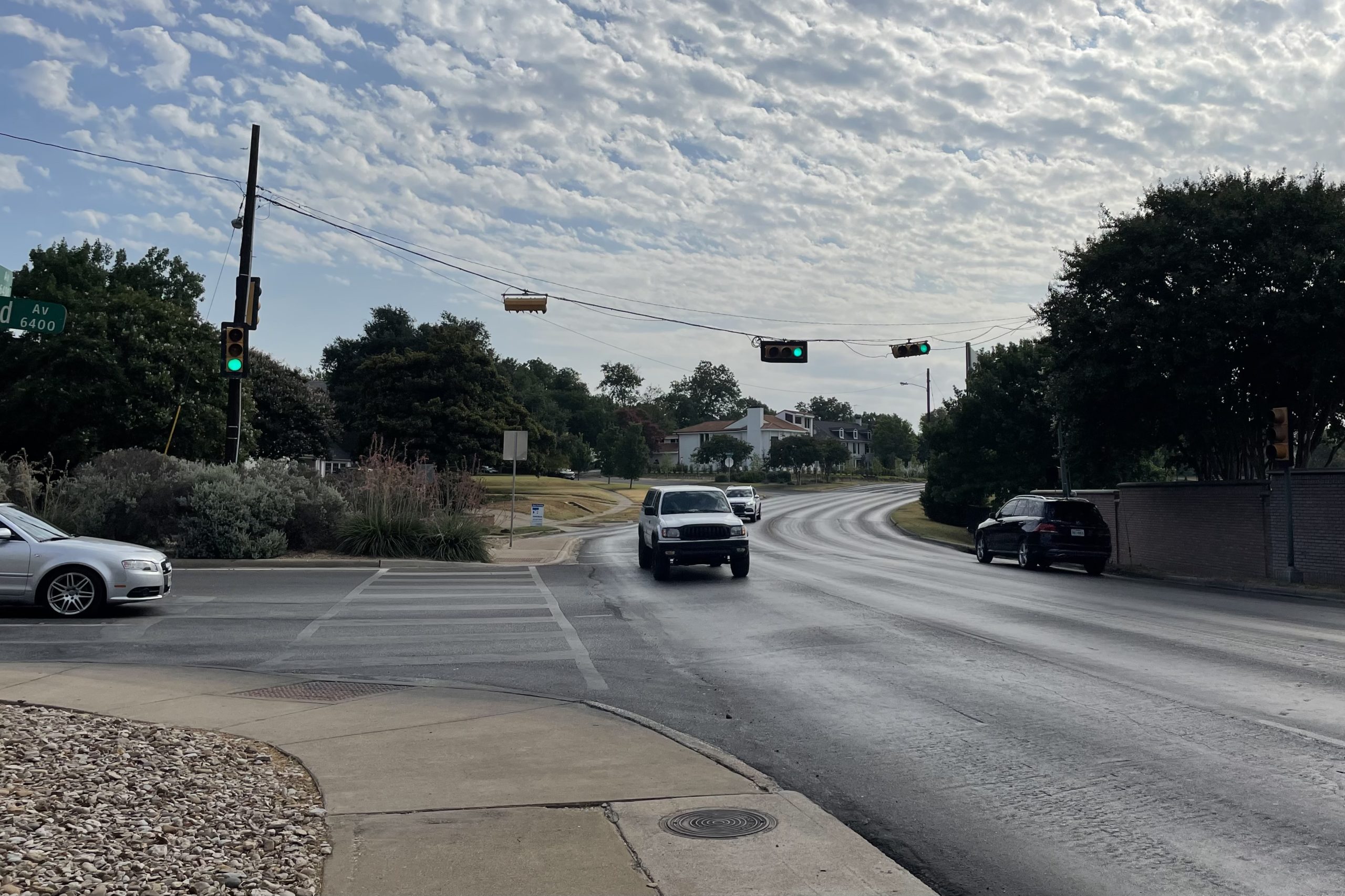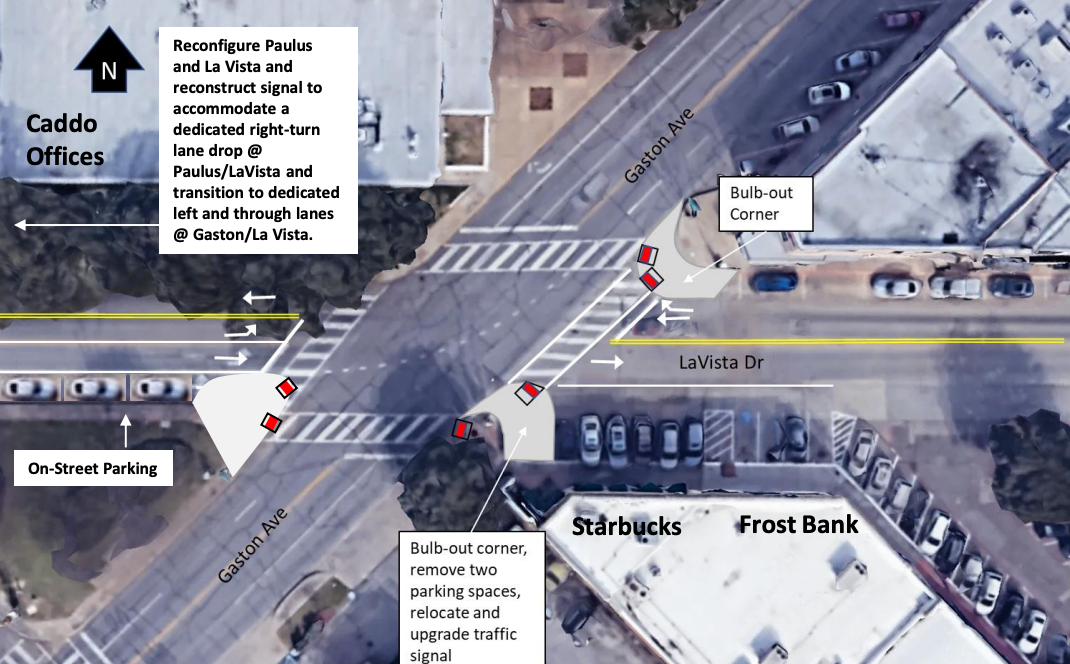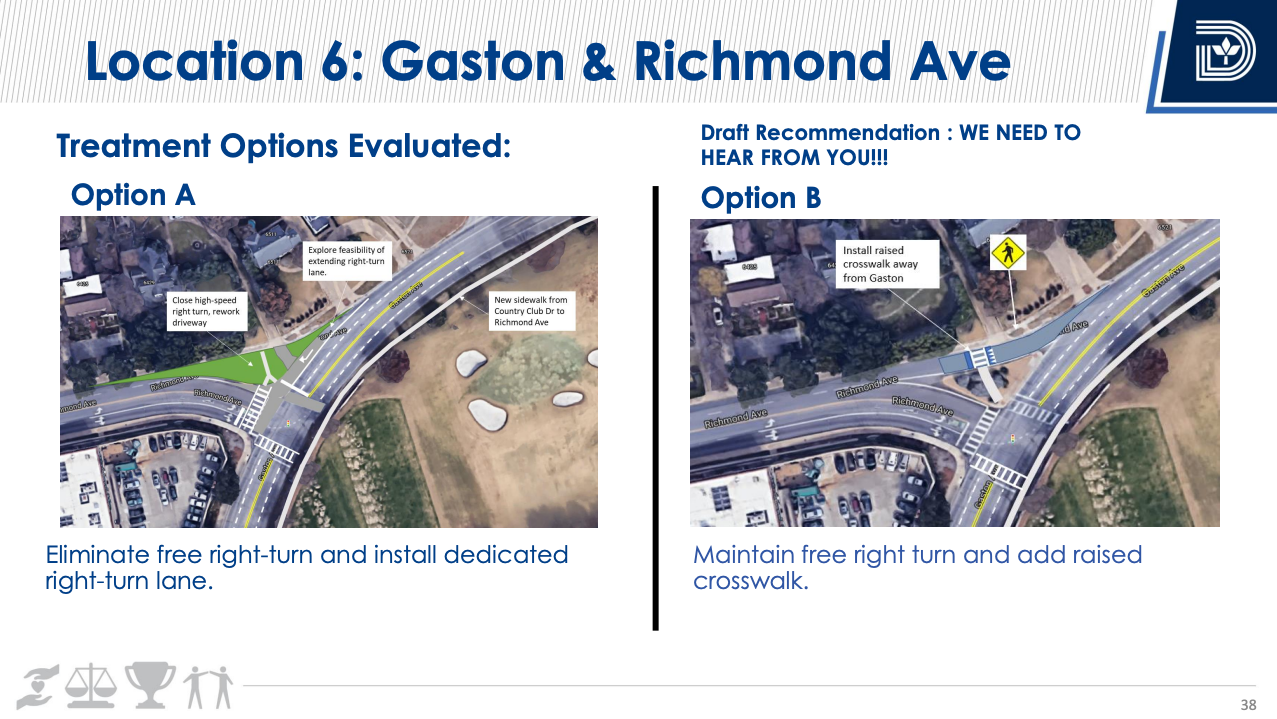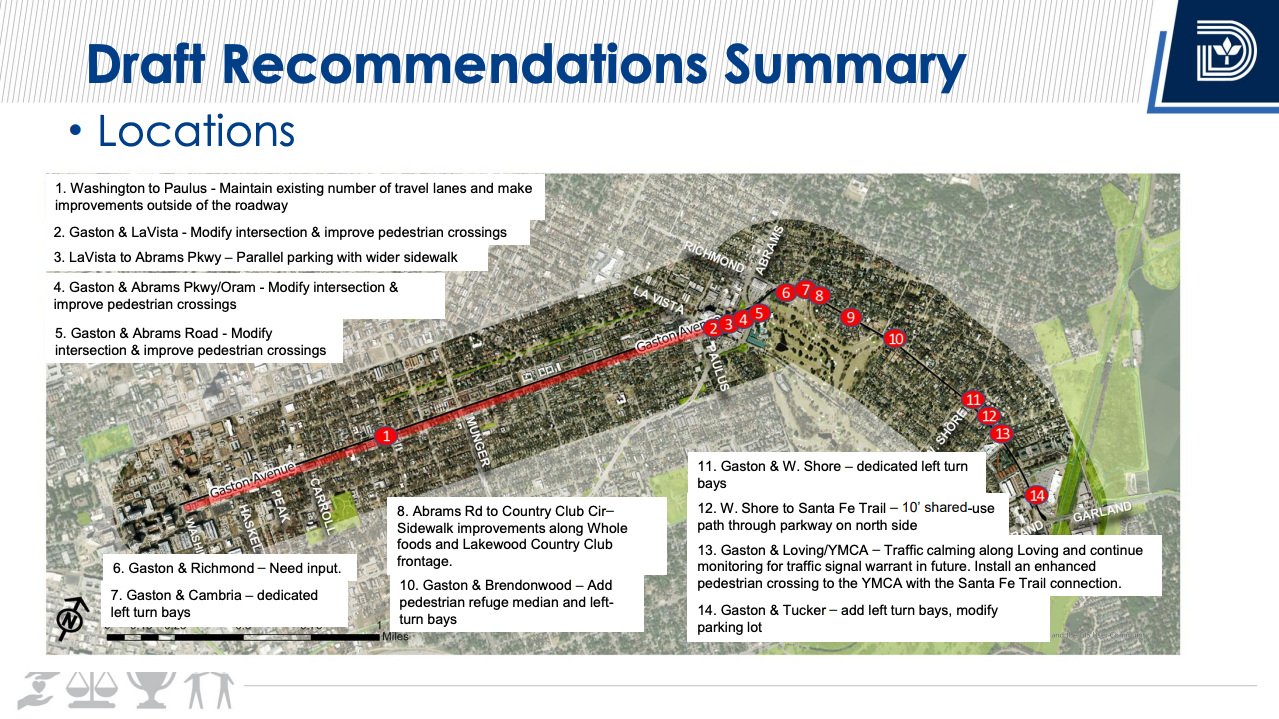
Gaston Avenue at Richmond Avenue. Photo by Renee Umsted.
Update (Aug. 5): The City of Dallas survey is now available through Aug. 12.
A year after the first public meeting, the City of Dallas presented recommendations to the public on potential improvements to the Gaston Avenue corridor.
Meeting attendees heard from Chief Planner Kathryn Rush and Gus Khankarli, the director of the Dallas Department of Transportation, and they were given an opportunity to provide feedback.
Among the attendees were members of the steering committee, a group of 17 City Council-appointed individuals from District 2, District 9 and District 14. The committee has had meetings to discuss potential options for the Gaston Avenue Corridor, which spans 3.7 miles from Washington Avenue near Baylor Hospital to the Gaston-Garland-Grand intersection. There was also an initial public input round, which occurred last year.
None of the improvements (outlined in this presentation) are finalized, and the City wants to hear from neighbors. A survey is available online until Aug. 5.
In general, people at the meeting were in agreement that speeding on Gaston Avenue is an important issue, and it often leads to crashes. But there were different ideas about how to handle the problem.
One neighbor suggested lowering the speed limit (which ranges from 30 mph-35 mph along Gaston), but Khankarli says speed limits are set by federal rules, and when speed studies are completed, the results may show the need to raise, rather than lower, the limit.
Gaston Avenue resident David Bailey says changing the speed limits wouldn’t matter because a reduced speed limit wouldn’t be enforced.
“You could put a 10 mile an hour speed limit,” Bailey says. “The 30 mile doesn’t work. A 10 mile doesn’t work.”
Rather, he suggested implementing a road diet, adding a bunch of traffic signals or just letting the traffic build up; but according to the planners, those options aren’t feasible throughout the whole corridor.
The planners identified six “character zones” along Gaston, corresponding to unique neighborhoods or areas: Baylor Medical Center, Peak’s Suburban Addition, Munger/Swiss/Junius, Lakewood Central Commercial, Lakewood/La Vista and Gaston Commercial Gateway. But among them, neighbors have identified issues in common, such as speeding, crashes, problems with left turns, a lack of accessibility for pedestrians, parking and more.
Baylor Medical Center, Peak’s Suburban Addition, Munger/Swiss/Junius
Near Baylor Medical Center, a road diet — reducing the four-lane roadway to three — was considered. But if that option were pursued, Dallas Fire-Rescue would anticipate increased response times for emergency vehicles, and DART was concerned about buses becoming trapped in pull-out bays. So the planners’ recommended option for that area is making improvements outside of the roadway, such as upgrading traffic signals and improving sidewalks.
“It seems little, but once you combine them all together, I think you can get something really impactful,” Rush says.
Melanie Vanlandingham, a member of the steering committee representing District 14, says she wasn’t happy with the recommendations for this area, from Washington to Paulus.
“If Gaston is a primary corridor, even heavier than Live Oak, then DART, I would submit, needs to rethink their routing and put the buses back on Live Oak,” Vanlandingham says. “That would considerably take the conflicts of bus traffic off of Gaston. Now that’s a big change, but that’s what Vision Zero is all about — big change. And doing nothing from Washington to Paulus operationally on Gaston Avenue is defeating the purpose of the study.”
Rush says DART told the Department of Transportation that there is a high ridership on Gaston Avenue, but not really on Live Oak.
Lakewood Central Commercial (Paulus Avenue to Abrams Road)
At Gaston’s intersection with La Vista, the planners recommended upgrading the traffic signals and adding bulb-outs to shorten crossing distances for pedestrians (see photo below). The bulb-outs would remove two parking spaces in front of Starbucks, but if one eastbound lane on La Vista was converted into a parking lane, a few on-street, parallel parking spaces could be added.

Via Gaston Avenue Corridor Study public meeting — draft recommendations, July 19, 2022.
The planners also recommended replacing the pull-in parking on Gaston by Craft Beer Cellar and T-Mobile with parallel parking and widening the sidewalks by five feet. This would remove five to seven parking spots.
At the next intersection, Gaston and Abrams Parkway/Oram Street, the preferred draft recommendation (see slide 32) involves reorienting the intersection to align with Oram Street to improve visibility, bringing together the legs of Abrams Parkway on the west side of Gaston and reversing the flow of the CVS parking.
The alternative recommendation (see slide 33 on the presentation) keeps Abrams Parkway aligned on both sides of Gaston Avenue and relocates the entrance to the CVS parking lot; it also calls for a median on Gaston.
Lakewood/La Vista (Abrams Road to Loving Avenue)
At the Gaston-Richmond intersection, cars often speed through the free right turn.
Planners didn’t have a draft recommendation for this site, though they propose two options. One is to get rid of the free right turn and add a dedicated right-turn lane. The other option is to keep the free right turn and add a raised crosswalk that Rush says “would basically come up to curb level, so it’d be like you never stepped on the street.” Khankarli says further engineering studies would need to be done.

Via Gaston Avenue Corridor Study public meeting — draft recommendations, July 19, 2022.
The next intersection considered was Gaston at Cambria. Planners recommend doing away with the splitter island, creating a dedicated left-turn lane on Cambria and bringing both legs of Cambria to a point. A pedestrian crosswalk would also be added.
At several locations along Gaston, including its intersections with Pearson and Brendenwood, the City found that a traffic signal is not warranted. Khankarli says the Federal Highway Administration has eight warrants, or possibilities, that call for a signal to be installed, and the City has to comply with those regulations.
If a signal is warranted at Brendenwood in the future, the City would want to install left-turn lanes and a median for pedestrians, along with signs, lighting and a pedestrian signal. The City would also need to acquire right-of-way to build a wide sidewalk and landscaped buffer.
The Gaston-West Shore intersection is another site where many crashes occur. Planners recommended installing left-turn lanes and acquiring right-of-way on the south side of Gaston to relocate the traffic signal.
Along the north side of Gaston between West Shore and the Santa Fe Trail connection, the planners suggested adding a 10-foot trail in the existing right-of-way.
Gaston Central Commercial (Loving Avenue to Garland Road)
A traffic signal isn’t warranted at Loving, planners say, but the recommendation is to install a signalized pedestrian crossing to the White Rock YMCA with the Santa Fe Trail connection.
Crashes also occur at Gaston’s intersection with Tucker, especially those related to left turns. So planners recommend adding left-turn lanes, which would require expanding Gaston and modifying the parking lot.
A three-lane road diet was not really a consideration along Gaston from Richmond to the Gaston-Garland-Grand intersection, Rush says, because the road is almost at capacity, and it’s a “community collector” that allows transportation between 3G and Downtown.
“We didn’t even need to do a traffic study to tell us that everything would kind of come to a halt,” Rush says.
The image below (slide 56 in the presentation) shows an overview of the recommendations. Take the survey to share your thoughts with the City; the deadline is Aug. 5.

Via Gaston Avenue Corridor Study public meeting — draft recommendations, July 19, 2022.





